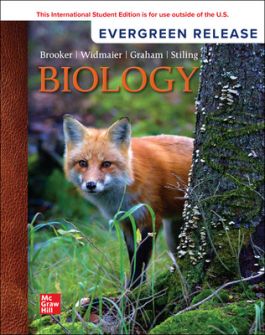Biology: 2025 Release ISE
2. The Chemical Basis of Life I: Atoms, Molecules, and Water
3. The Chemical Basis of Life II: Organic Molecules
Unit II Cell
4. Evolutionary Origin of Cells and Their General Features
5. Membrane Structure, Synthesis, and Transport
6. An Introduction to Energy, Enzymes, and Metabolism
7. Cellular Respiration and Fermentation
8. Photosynthesis
9. Cell Communication
10. Multicellularity
Unit III Genetics
11. Nucleic Acid Structure, DNA Replication, and Chromosome Structure
12. Gene Expression at the Molecular Level I: Production of mRNAs and Proteins
13. Gene Expression at the Molecular Level II: Non-coding RNAs
14. Gene Expression at the Molecular Level III: Gene Regulation
15. Mutation, DNA Repair, and Cancer
16. The Eukaryotic Cell Cycle, Mitosis, and Meiosis
17. Mendelian Patterns of Inheritance
18. Epigenetics, Extranuclear Inheritance, and Linkage
19. Genetics of Viruses and Bacteria
20. Developmental Genetics
21. Genetic Technologies and Genomics
Unit IV Evolution
22. An Introduction to Evolution
23. Population Genetics
24. Origin of Species and Macroevolution
25. Taxonomy and Systematics
26. History of Life on Earth and Human Evolution
Unit V Diversity
27. Archaea and Bacteria
28. Protists
29. Fungi
30. Microbiomes: Microbial Systems On and Around Us
31. Plants and the Conquest of Land
32. The Evolution and Diversity of Modern Gymnosperms and Angiosperms
33. An Introduction to Animal Diversity
34. The Invertebrates
35. The Vertebrates
Unit VI Flowering Plants
36. An Introduction to Flowering Plant Form and Function
37. Flowering Plants: Behavior
38. Flowering Plants: Nutrition
39. Flowering Plants: Transport
40. Flowering Plants: Reproduction
Unit VII Animals
41. Animal Bodies and Homeostasis
42. Neuroscience I: Cells of the Nervous System
43. Neuroscience II: Evolution, Structure, and Function of the Nervous System
44. Neuroscience III: Sensory Systems
45. Musculoskeletal Systems and Locomotion
46. Nutrition and Animal Digestive Systems
47. Control of Energy Balance, Metabolic Rate, and Body Temperature
48. Circulatory and Respiratory Systems
49. Excretory Systems
50. Endocrine Systems
51. Animal Reproduction and Development;
52. Immune Systems
53. Integrated Responses of Animal Organ Systems to a Challenge to Homeostasis
Unit VIII Ecology
54. An Introduction to Ecology and Biomes
55. Behavioral Ecology
56. Population Ecology
57. Species Interactions
58. Communities and Ecosystems: Ecological Organization on Large Scales
59. The Ecological Impact of Humans
60. Biodiversity and Conservation Biology
McGraw Hill Connect is an award-winning digital teaching and learning solution that empowers students to achieve better outcomes and enables instructors to improve course management efficiency.
High-Quality Course Material
Our trusted solutions are designed to help students actively engage in course content and develop critical higher-level thinking skills while offering you the flexibility to tailor your course to the ways you teach and the ways your students learn.
Assignments & Automatic Grading
Connect features a question bank that you can select from to create homework, practice tests and quizzes. Dramatically reduce the amount of time you spend reviewing homework and grading quizzes, freeing up your valuable time to spend on teaching.
Analytics & Reporting
Monitor progress and improve focus with Connect’s visual and actionable dashboards. Reports are available to empower both instructors and students with real-time performance analytics.
Seamless Integration
Link your Learning Management with Connect for single sign-on and gradebook synchronization, with all-in-one ease for you and your students.


